Quantitative Interpretation of TOC in Complicated Lithology Based on Well Log Data: A Case of Majiagou Formation in the Eastern Ordos Basin, China
Abstract
:1. Introduction
2. Geological Background
3. Data Preparation
3.1. Optimal Sampling
3.2. Correlation Analysis of Logging Curves
4. Methods and Results
4.1. ΔlogR Method
4.1.1. Traditional ΔlogR Method
4.1.2. Improved ΔlogR Method
4.1.3. Interpretation Effect Analysis of the ΔlogR Method
4.2. Neural Network Method
4.2.1. Basic Principle
4.2.2. Construction of Neural Network
4.2.3. Interpretation Effect Analysis of Neural Network Method
5. Discussion
6. Conclusions
Author Contributions
Funding
Institutional Review Board Statement
Informed Consent Statement
Data Availability Statement
Conflicts of Interest
References
- Schmokerj, W. Determination of Organic-Matter Content of Appalachian Devonian Shales from Gamma-Ray Logs. AAPG Bull. 1981, 65, 1285–1298. [Google Scholar]
- Chen, Z.; Hao, S.; Xi, S. Logging Evaluation Method for Organic Matter Abundance of Carbonate Source Rock. J. Univ. Pet. (Ed. Nat. Sci.) 1994, 18, 16–19. [Google Scholar]
- Xu, S.; Zhu, Y. Well logs response and prediction model of organic carbon content in source rocks—a case study from the source rock of Wenchang formation in the pearl mouth basin. Pet. Geol. Exp. 2010, 32, 290. [Google Scholar]
- Du, W.; Wang, P.; Liang, M. Well logs response characteristics and quantitative prediction model of organic carbon content of hydrocarbon source rocks in coal-bearing strata measures. J. China Coal Soc. 2016, 41, 954–963. [Google Scholar]
- Passey, Q.R.; Creaney, S.; Kulla, J.B.; Stroud, J.D. A Practical Model for Organic Richness from Porosity and Resistivity Logs. AAPG Bull. 1990, 74, 1777–1794. [Google Scholar]
- Yu, H.; Rezaee, R.; Wang, Z.; Han, T.; Zhang, Y.; Arif, M.; Johnson, L. A new method for TOC estimation in tight shale gas reservoirs. Int. J. Coal Geol. 2017, 179, 269–277. [Google Scholar] [CrossRef] [Green Version]
- Yan, J.; Cai, J.; Zhao, M.H.; Zheng, D.S. Advances in the study of source rock evaluation by geophysical logging and its significance in resource assessment. Prog. Geophys. 2009, 24, 270–279. [Google Scholar]
- Meng, Z.; Guo, Y.; Liu, W. Relationship between organic carbon content of shale gas reservoir and logging parameters and its prediction model. J. China Coal Soc. 2015, 40, 247–253. [Google Scholar]
- Tan, M.; Bai, Y.; Wang, Q.; Wu, J.; Shi, Y.J.; Li, G.R.; Wei, X.P. Proceedings of the 2019 Oil and Gas Geophysics Annual Conference; Oil and Gas Geophysics Professional Committee of the Chinese Geophysical Society: Nanjing, China, 2019. [Google Scholar]
- Alizadeh, B.; Najjari, S.; Kadkhodaie-Ilkhchi, A. Artificial neural network modeling and cluster analysis for organic facies and burial history estimation using well log data: A case study of the South Pars Gas Field, Persian Gulf, Iran. Comput. Geosci. 2012, 45, 261–269. [Google Scholar] [CrossRef]
- Bakhtiar, H.A.; Telmadarreie, A.; Shayesteh, M.; Fard, M.H.H.; Talebi, H.; Shirband, Z. Estimating Total Organic Carbon Content and Source Rock Evaluation, Applying ΔlogR and Neural Network Methods: Ahwaz and Marun Oilfields, SW of Iran. Liq. Fuels Technol. 2011, 29, 1691–1704. [Google Scholar] [CrossRef]
- Li, Z.; Du, W.; Hu, J.; Li, D. Prediction of shale organic carbon content support vector machine based on logging parameters. Coal Sci. Technol. 2019, 47, 199–204. [Google Scholar]
- Rui, J.; Zhang, H.; Zhang, D.; Han, F.; Guo, Q. Total organic carbon content prediction based on support-vector-regression machine with particle swarm optimization. J. Pet. Sci. Eng. 2019, 180, 699–706. [Google Scholar] [CrossRef]
- Amosu, A.; Imsalem, M.; Sun, Y. Effective machine learning identification of TOC-rich zones in the Eagle Ford Shale. J. Appl. Geophys. 2021, 188, 104–113. [Google Scholar] [CrossRef]
- Liu, X.; Lei, Y.; Luo, X.; Wang, X.; Chen, K.; Cheng, M.; Yin, J. TOC determination of Zhangjiatan shale of Yanchang formation, Ordos Basin, China, using support vector regression and well logs. Earth Sci. Inform. 2021, 14, 22–34. [Google Scholar] [CrossRef]
- Zhao, W.; Gao, H.; Yan, G.; Guo, T. TOC prediction technology based on optimal estimation and Bayesian statistics. Lithol. Reserv. 2020, 32, 86–93. [Google Scholar]
- Yin, M.; Cen, C.; Ruan, J.; He, W.W. Classification and prediction method of total organic carbon content in shale gas reservoir based on Bayesian discrimination. J. Geol. 2020, 44, 362–369. [Google Scholar]
- Rui, J.; Zhang, H.; Ren, Q.; Yan, L.; Guo, Q.; Zhang, D. TOC content prediction based on a combined Gaussian process regression model. Mar. Pet. Geol. 2020, 118, 104–118. [Google Scholar] [CrossRef]
- Li, G.; Zhao, T.; Shi, Y.; Hu, C.; Chen, Z.; Fan, X.; Li, D.; Lai, J. Diagenetic facies logging recognition and evaluation of carbonate reservoirs in Majiagou Formation, Ordos Basin. Acta Pet. Sin. 2018, 39, 1141–1154. [Google Scholar]
- Guo, Y.; Zhao, Z.; Zhang, Y.; Xu, W.; Bao, H.; Zhang, Y.; Gao, J.; Song, W. Development characteristics and new exploration areas of marine source rock in Ordos Basin. Acta Pet. Sin. 2016, 37, 939–951. [Google Scholar]
- Qin, J.Q.; Fu, D.L.; Qian, Y.F.; Yang, F.; Tian, T. Progress of geophysical methods for the evaluation of TOC of source rock. Geophys. Prospect. Pet. 2018, 57, 803–812. [Google Scholar]
- Dong, H.C. Application of natural gamma spectroscopy logging. Petrochem. Ind. Technol. 2017, 24, 260. [Google Scholar]
- Zhong, W.J.; Li, H.; Ge, Z.W.; Dong, X.X. Optimum method for calculating organic carbon content from logging data—Taking Longmaxi Formation Shale in X area of southern Sichuan as an example. China Pet. Chem. Stand. Qual. 2020, 40, 12–14. [Google Scholar]
- Bian, L.; Liu, G.; Sun, M.; Yang, D.; Wan, W.; Zhang, Y. Improved ΔlogR technique and its application to predicting total organic carbon of source rocks with middle and deep burial depth. Pet. Geol. Recovery Effic. 2018, 25, 40–45. [Google Scholar]
- Jadid, M.N.; Fairbairn, D.R. The application of neural network techniques to structural analysis by implementing an adaptive finite-element mesh generation. AI EDAM 1994, 8, 177–191. [Google Scholar] [CrossRef]
- Chen, M. Analysis and Compare of BP Neural Network’s Training Arithmetic. Sci. Technol. Plaza 2010, 23, 24–27. [Google Scholar]
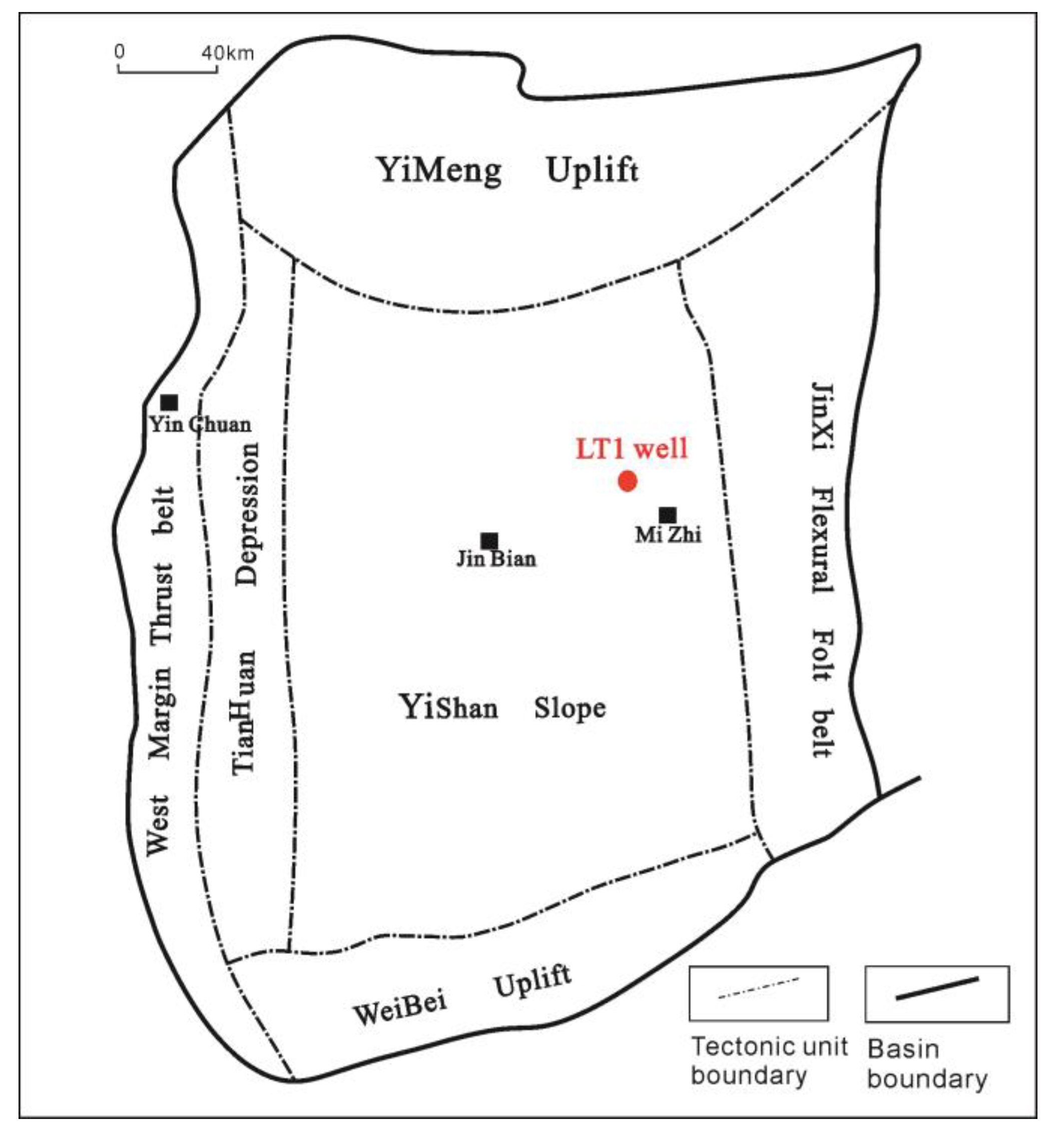

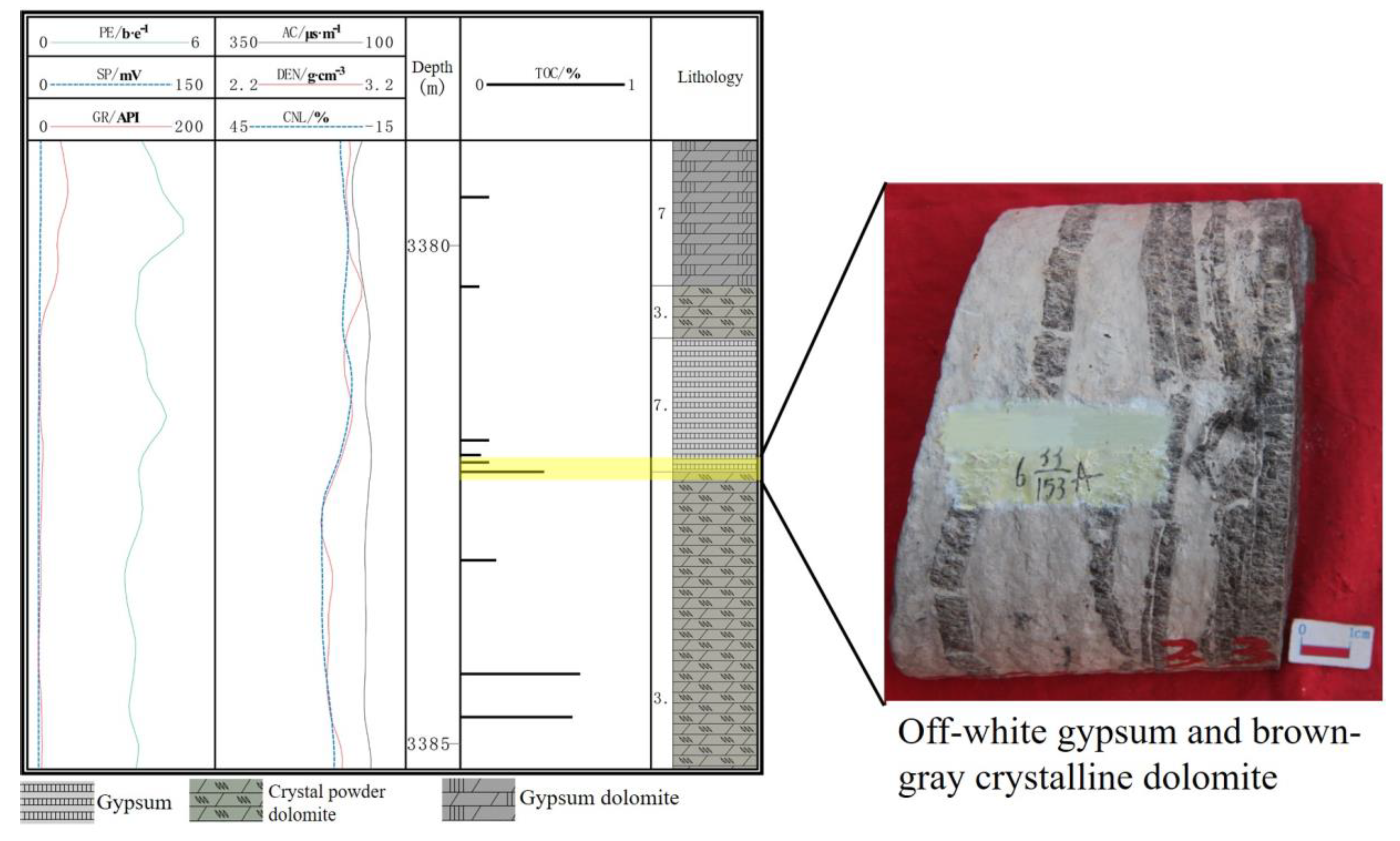
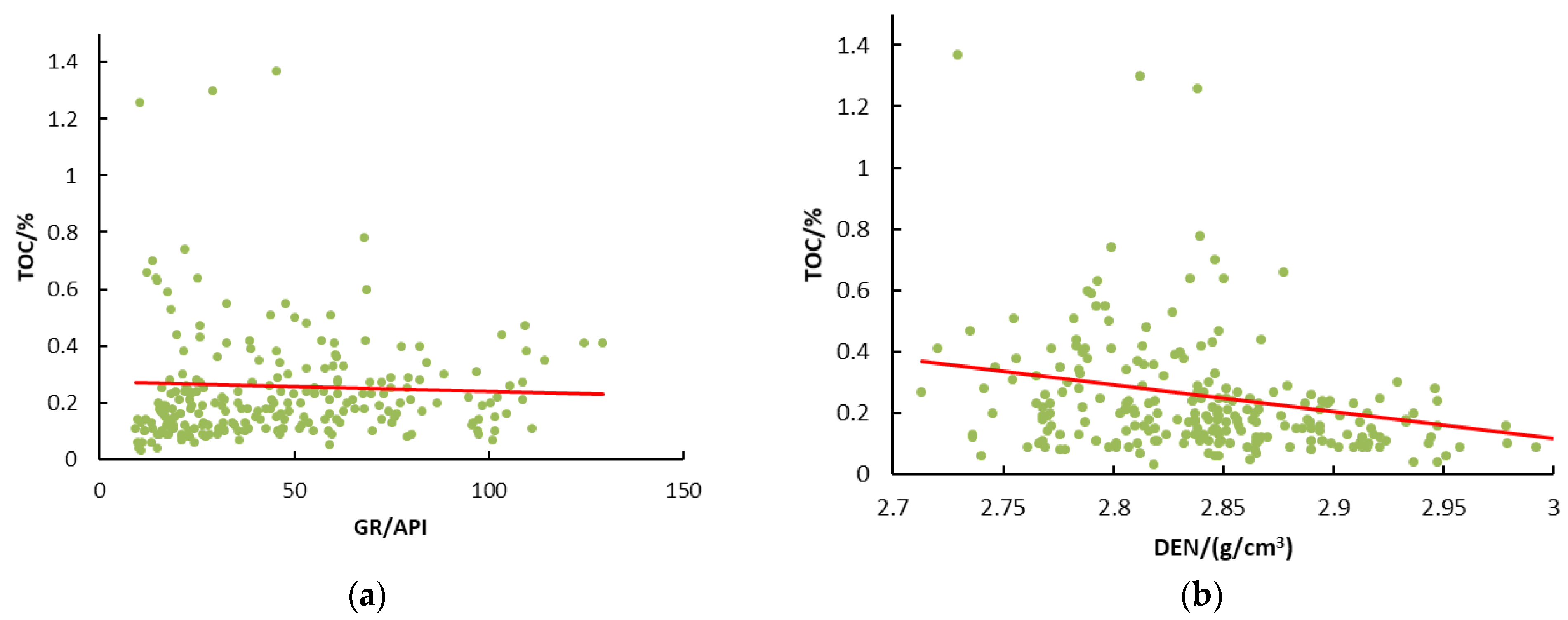


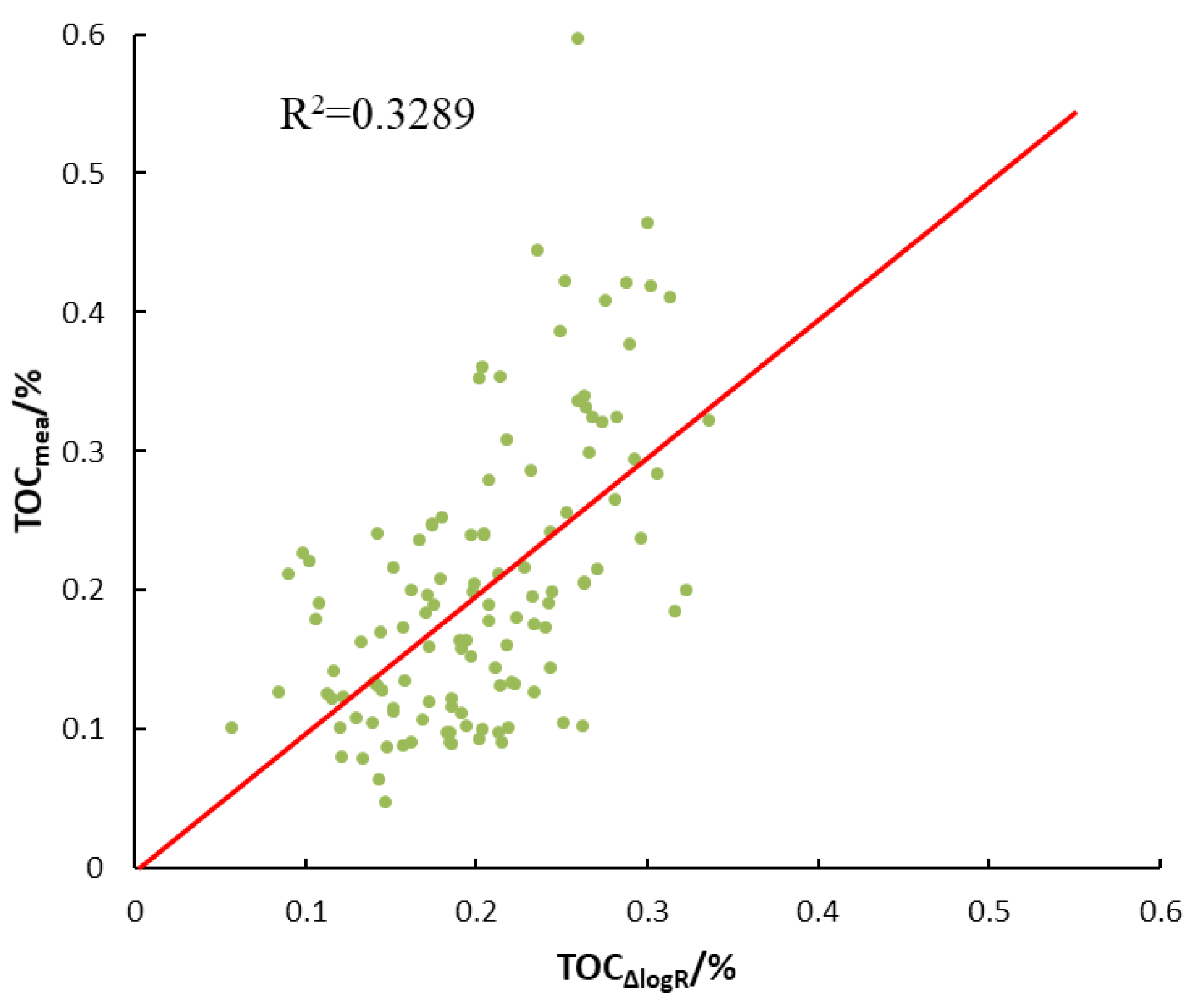
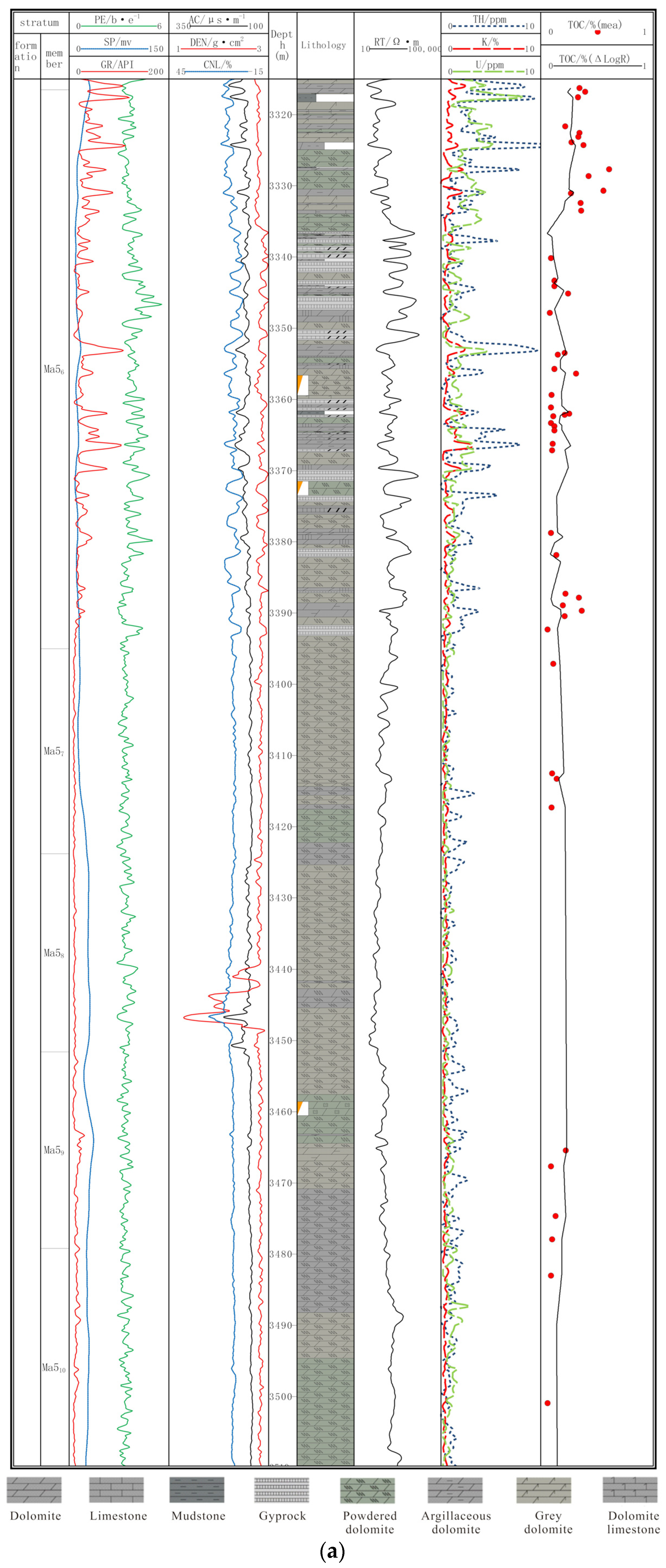

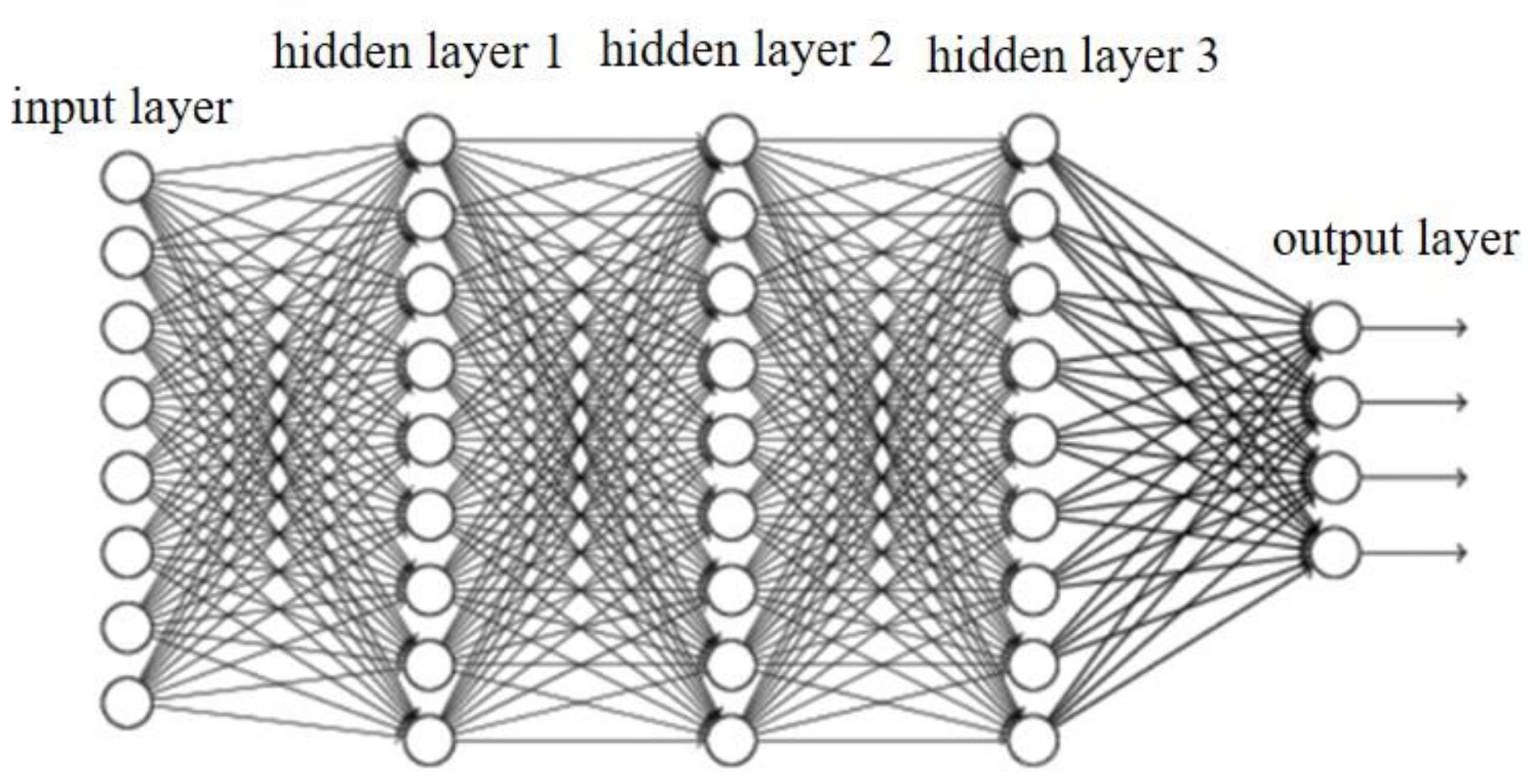

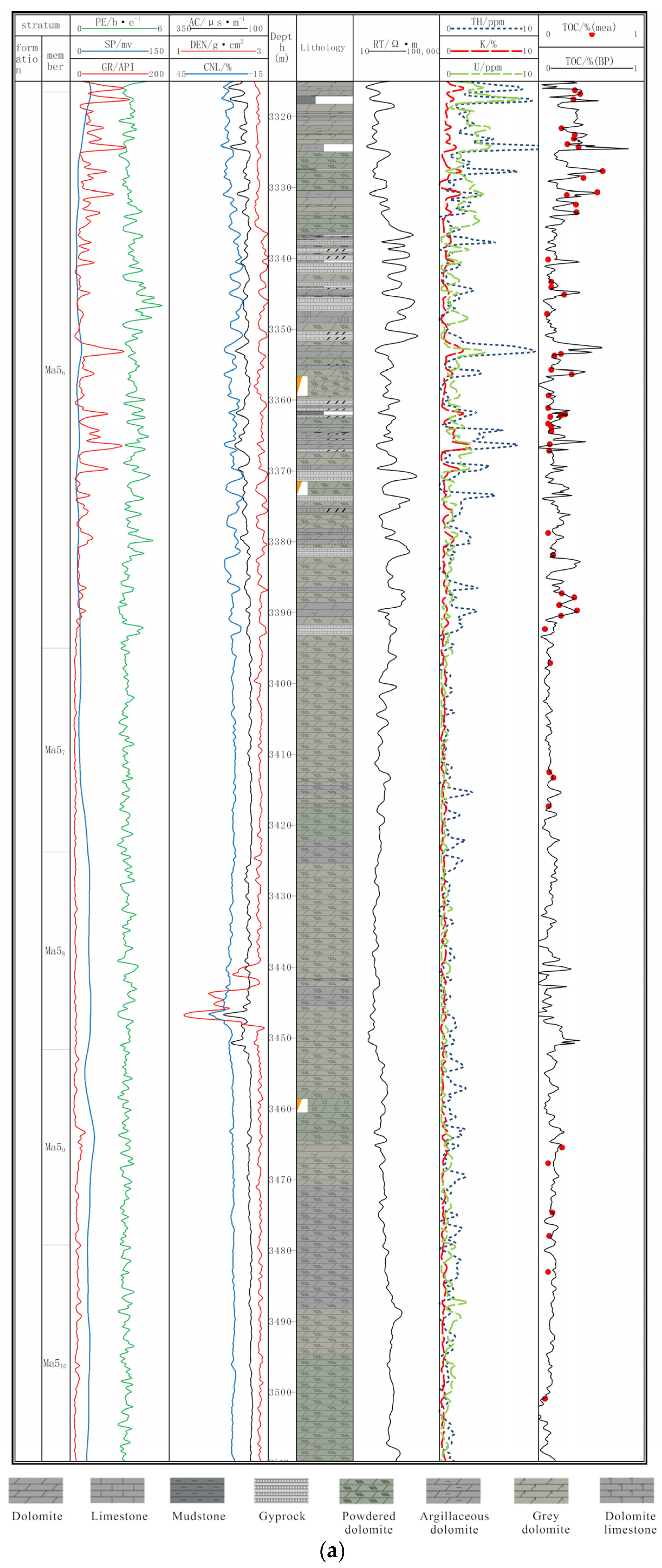
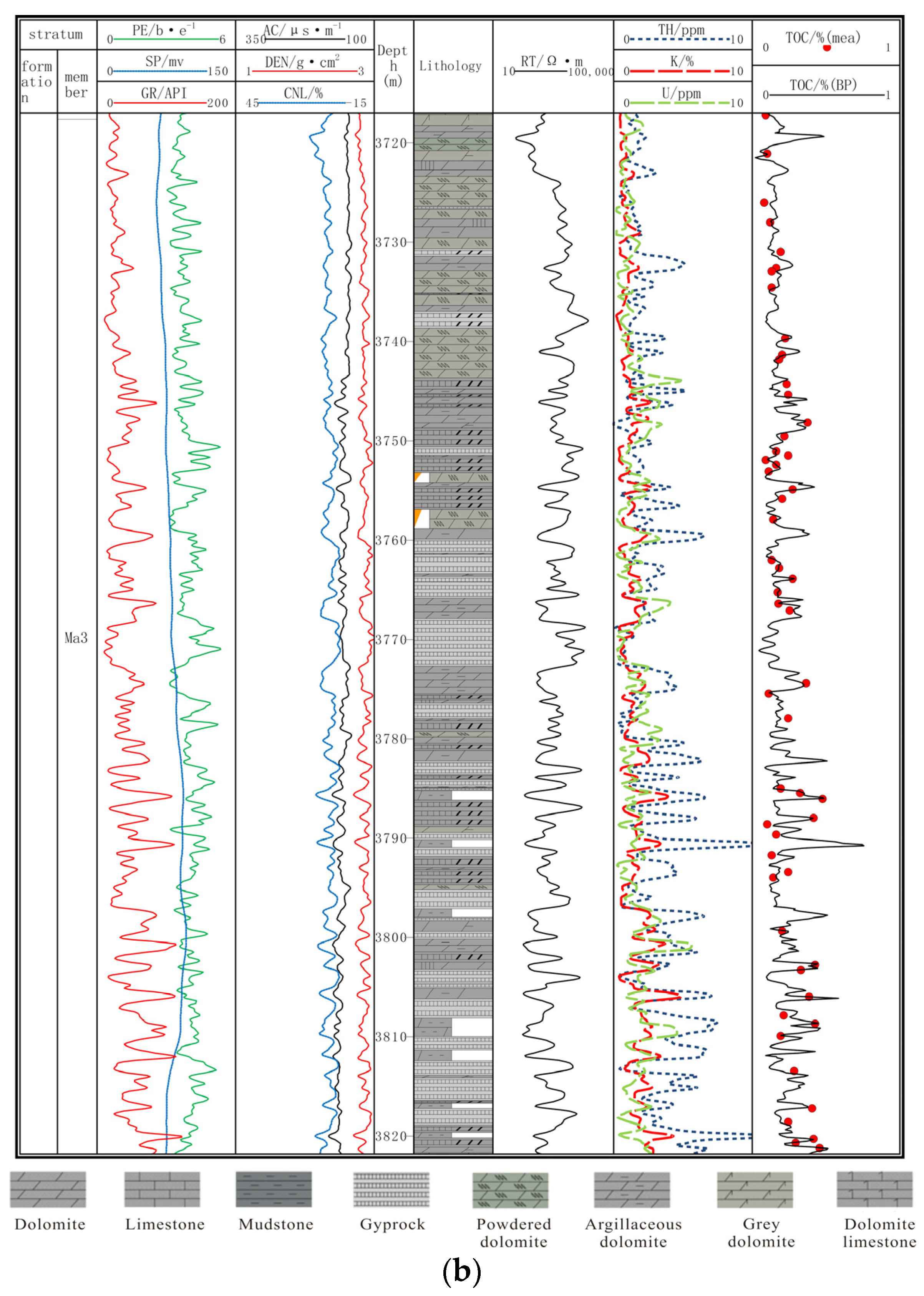
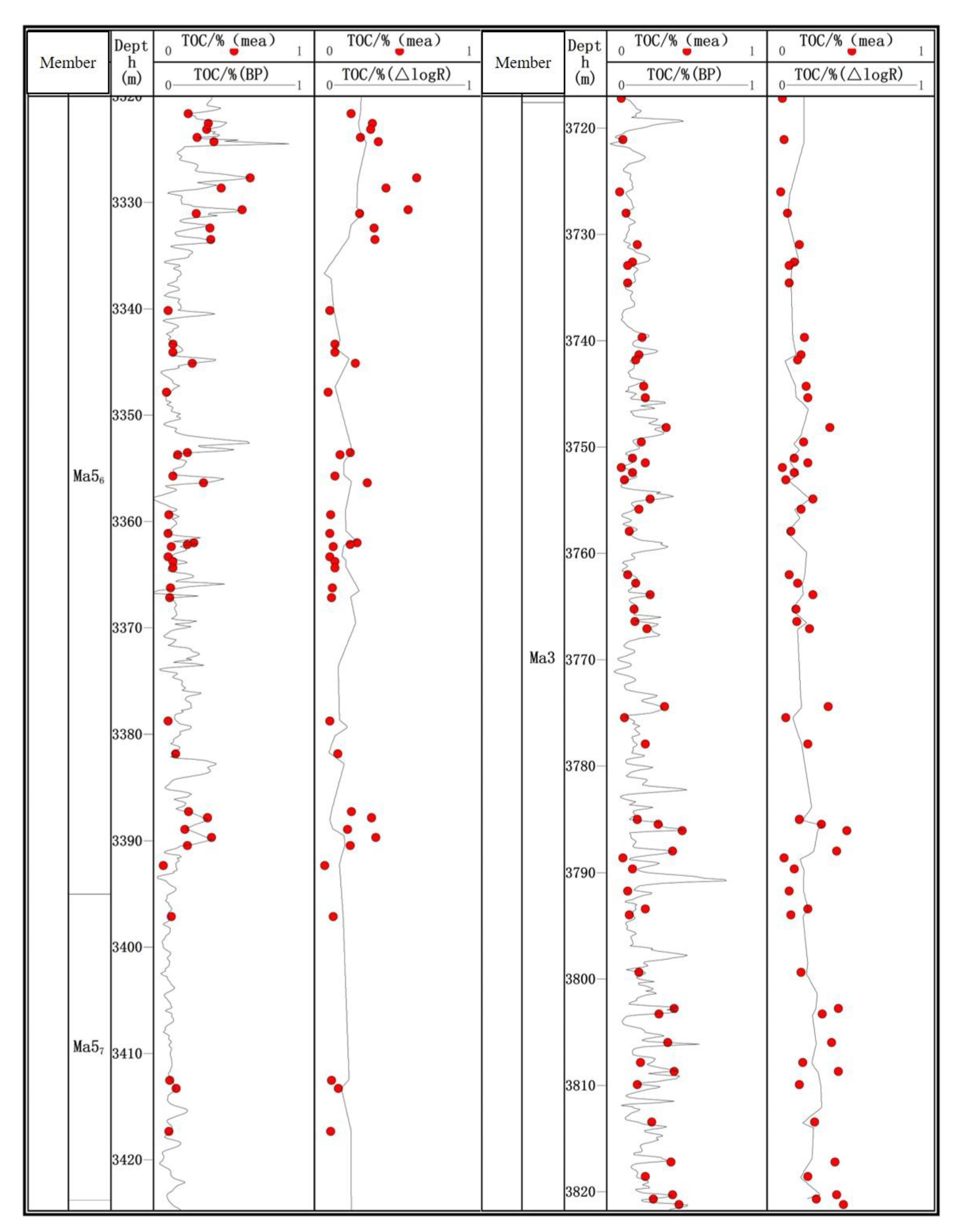
| GR | AC | DEN | CNL | RT | TH | K | U | |
|---|---|---|---|---|---|---|---|---|
| T | 8.9300 | 5.8818 | 8.5079 | 6.5592 | 3.9892 | 7.7918 | 7.9166 | 4.8520 |
| R | 0.5509 | 0.4144 | 0.5344 | 0.4484 | 0.3059 | 0.5058 | 0.5101 | 0.3579 |
| R2 | 0.3035 | 0.1717 | 0.2856 | 0.2011 | 0.0936 | 0.2548 | 0.2602 | 0.1281 |
| Number of Nodes | 3 | 4 | 5 | 6 | 7 | 8 | 9 | 10 | 11 | 12 | 13 |
|---|---|---|---|---|---|---|---|---|---|---|---|
| Error/10−3 | 9.13 | 8.62 | 8.44 | 6.52 | 6.89 | 5.75 | 5.26 | 5.82 | 6.14 | 5.97 | 6.25 |
| Correlation/10−1 | 7.27 | 7.26 | 7.34 | 8.51 | 7.45 | 9.01 | 9.39 | 8.82 | 9.16 | 8.78 | 8.24 |
| R2 | MAE | MRE | RMSE | |
|---|---|---|---|---|
| ΔLogR method | 0.33 | 0.0671 | 33.02% | 8.41% |
| Neural network method | 0.83 | 0.0322 | 15.88% | 4.30% |
Publisher’s Note: MDPI stays neutral with regard to jurisdictional claims in published maps and institutional affiliations. |
© 2021 by the authors. Licensee MDPI, Basel, Switzerland. This article is an open access article distributed under the terms and conditions of the Creative Commons Attribution (CC BY) license (https://creativecommons.org/licenses/by/4.0/).
Share and Cite
Hu, S.; Zhang, H.; Zhang, R.; Jin, L.; Liu, Y. Quantitative Interpretation of TOC in Complicated Lithology Based on Well Log Data: A Case of Majiagou Formation in the Eastern Ordos Basin, China. Appl. Sci. 2021, 11, 8724. https://doi.org/10.3390/app11188724
Hu S, Zhang H, Zhang R, Jin L, Liu Y. Quantitative Interpretation of TOC in Complicated Lithology Based on Well Log Data: A Case of Majiagou Formation in the Eastern Ordos Basin, China. Applied Sciences. 2021; 11(18):8724. https://doi.org/10.3390/app11188724
Chicago/Turabian StyleHu, Shuiqing, Haowei Zhang, Rongji Zhang, Lingxuan Jin, and Yuming Liu. 2021. "Quantitative Interpretation of TOC in Complicated Lithology Based on Well Log Data: A Case of Majiagou Formation in the Eastern Ordos Basin, China" Applied Sciences 11, no. 18: 8724. https://doi.org/10.3390/app11188724
APA StyleHu, S., Zhang, H., Zhang, R., Jin, L., & Liu, Y. (2021). Quantitative Interpretation of TOC in Complicated Lithology Based on Well Log Data: A Case of Majiagou Formation in the Eastern Ordos Basin, China. Applied Sciences, 11(18), 8724. https://doi.org/10.3390/app11188724






